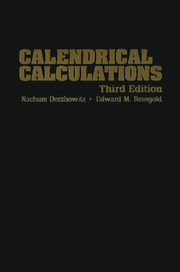Book contents
- Frontmatter
- Dedication
- Contents
- List of Frontispieces
- List of Figures
- List of Tables
- Abbreviations
- Mathematical Notations
- Preface
- Credits
- License and Limited Warranty and Remedy
- About the Cover
- 1 Calendar Basics
- I ARITHMETICAL CALENDARS
- II ASTRONOMICAL CALENDARS
- 13 Time and Astronomy
- 14 The Persian Calendar
- 15 The Bahá'í Calendar
- 16 The French Revolutionary Calendar
- 17 The Chinese Calendar
- 18 The Modern Hindu Calendars
- 19 The Tibetan Calendar
- 20 Astronomical Lunar Calendars
- Coda
- III APPENDICES
- Index
- Envoi
- About the Cover
15 - The Bahá'í Calendar
Published online by Cambridge University Press: 05 February 2014
- Frontmatter
- Dedication
- Contents
- List of Frontispieces
- List of Figures
- List of Tables
- Abbreviations
- Mathematical Notations
- Preface
- Credits
- License and Limited Warranty and Remedy
- About the Cover
- 1 Calendar Basics
- I ARITHMETICAL CALENDARS
- II ASTRONOMICAL CALENDARS
- 13 Time and Astronomy
- 14 The Persian Calendar
- 15 The Bahá'í Calendar
- 16 The French Revolutionary Calendar
- 17 The Chinese Calendar
- 18 The Modern Hindu Calendars
- 19 The Tibetan Calendar
- 20 Astronomical Lunar Calendars
- Coda
- III APPENDICES
- Index
- Envoi
- About the Cover
Summary
In the not far distant future it will be necessary that all peoples in the world agree on a common calendar. It seems, therefore, fitting that the new age of unity should have a new calendar free from the objections and associations which make each of the older calendars unacceptable to large sections of the world's population, and it is difficult to see how any other arrangement could exceed in simplicity and convenience that proposed by the Báb.
—John Ebenezer Esslemont: Bahá'u'lláh and the New Era: An Introduction to the Bahá'íFaith (1923)Structure
The Bahá'í (or Badī') calendar begins its years on the day of the vernal equinox. Theoretically, if the actual time of the equinox occurs after sunset, then the year should begin a day later [2]. Current practice in the West, however, is to begin on March 21 of the Gregorian calendar, regardless. The theoretical, astronomical version of the Bahá'í calendar is described in Section 15.3. The calendar is based on the 19-year cycle 1844–1863 of the Bāb, the martyred forerunner of Baha'u'llāh and co-founder of the Bahá'í faith.
As in the Islamic calendar, days are from sunset to sunset. Unlike the Islamic calendar, years are solar; they are composed of 19 months of 19 days each with an additional period of 4 or 5 days after the eighteenth month. Leap years in the West follow the same pattern as in the Gregorian calendar.
- Type
- Chapter
- Information
- Calendrical Calculations , pp. 229 - 238Publisher: Cambridge University PressPrint publication year: 2007



